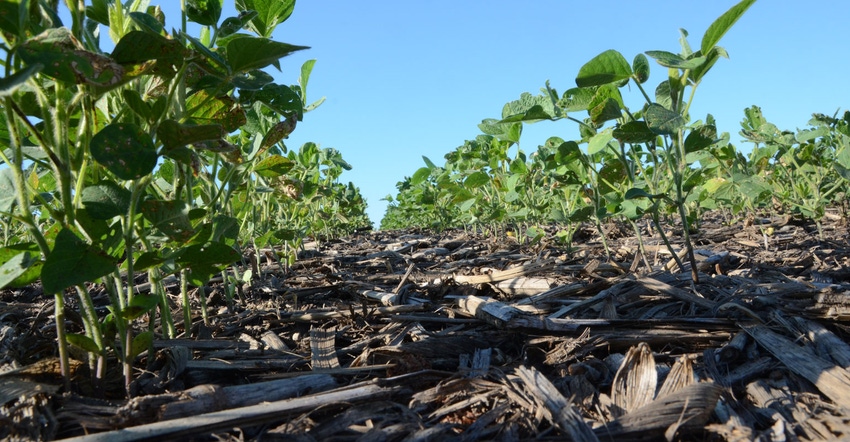January 8, 2021

A lot of thought goes into the technology you buy on the farm, and in 2021 you have a major choice for soybean herbicide technology: XtendFlex or Enlist E3. But once you’ve made that choice, what next?
“The first step is to be very familiar with the label for both products and the restrictions each require,” says Bob Hartzler, Extension weed specialist at Iowa State University. “I think that’s especially important with XtendFlex because of the added restrictions on application.”
These new technologies can offer significant benefits for farmers, but Hartzler along with Bryan Young, Extension weed scientist at Purdue University, advise getting fields off to a good start.
“It’s important that the preemerge herbicide is not just something you apply to have more flexibility in post-application timing,” Hartzler says. “[The preemerge] needs to be the frontline of defense. Then you’re using the 2,4-D or dicamba to control escapes, not control the bulk of the population.”
Hartzler looks back at the early days of Roundup Ready technology when preemerge herbicides became foundation products because Roundup controlled everything. That relegated the early herbicide application to the role of preventing early-season competition, and often at reduced rates.
Progressive accumulation of resistance in our primary target weeds to multiple postemergence herbicides has reduced herbicide options that can serve as a last defense for weed control in soybeans. That means the preemergence or preplant application of a multi-site-of-action herbicide tankmix must do more work, and full-rate applications are recommended. “We need to protect these post-compounds better than we did with glyphosate,” Hartzler says. “We can’t lay our total weed control program on the shoulders of those post-products.”
Adds Young: “You want to start off with a good soil residual herbicide. We should do the bulk of our weed management early in the season.”
The added tool available for XtendFlex and Enlist E3 for soybeans is the ability to use glufosinate in addition to having the option to use glyphosate with dicamba (XtendFlex) or 2,4-D (Enlist E3).
XtendFlex and 2021
New rules from EPA added the requirement of a volatility reduction agent (VRA) and expanded buffers for the spray area that farmers need to figure out before application. Hartzler says to look at the fields where you’re planning to use XtendFlex, as well as the surrounding landscape and what is adjacent to the field. With wider buffers, some fields may not be suitable.
In addition, Young advises getting a handle on what the neighbors are growing. Knowing what will be down wind when you apply is critical to avoiding drift issues, and the applicator is required by the herbicide label to know the presence of surrounding sensitive species.
As for the volatility reduction agents? Those are required and will add to the cost of using XtendFlex technology. Your dealer will have information on the products available. BASF has introduced Sentris for this purpose, and Bayer is launching VaporGrip Xtra as the VRA. Young notes that Bayer is licensing this technology to adjuvant makers, so you won’t buy a product called VaporGrip Xtra; it would be part of the adjuvant package. For example, Loveland has Delta Lock, a VaporGrip Xtra Agent.
Young notes that with the added VRA, the approved nozzles or product combinations may slightly change for use with XtendFlex. That information will be available in early 2021 on the website portion of the dicamba product labels.
For Enlist E3, there’s little change in the label for 2021.
Glyphosate or glufosinate?
With glufosinate added to the label, when post-spraying time comes, growers will have a choice. However, glufosinate in XtendFlex still needs to be vetted to join the list of approved herbicides for tank-mixing with dicamba, as indicated on the supplemental website label. At this time, glufosinate is not an approved tankmix with dicamba, and may not be cleared for 2021.
Regardless, Young recommends weed management should practice a more selective approach to herbicides, not just throwing the kitchen sink at the problem.
“If you’re dealing with grassy or perennial weeds, glyphosate would be the best choice in the tankmix,” Young says. “Glufosinate may be more ideal than glyphosate if dealing with glyphosate-resistant broadleaves like waterhemp, giant ragweed or Palmer amaranth. Glufosinate is not as good on grass as glyphosate.”
He is not automatically advocating a three-way tankmix with the auxin combined with glyphosate and glufosinate. Instead, Young notes that you pick one to match the weed spectrum — grassy or broadleaf — then you may have more options later in the season. If weed control fails with a three-way combination in your first pass, a plan B using the same three herbicides again as a rescue is not a best management practice.
“Since you have the opportunity to use glufosinate or glyphosate [with either technology], my recommendation would be to determine ahead of time what herbicide makes the most sense for your weed management strategy and weed spectrum in the first application,” Young says. “Know what you need in that first application, which may dictate your best option for any subsequent post applications.
“If you think you’ll get a late flush of grasses, you can clean that up with glyphosate. You want to understand where the weaknesses are for early post and later post. And we’re not talking about spraying bigger weeds.”
About the Author(s)
You May Also Like






